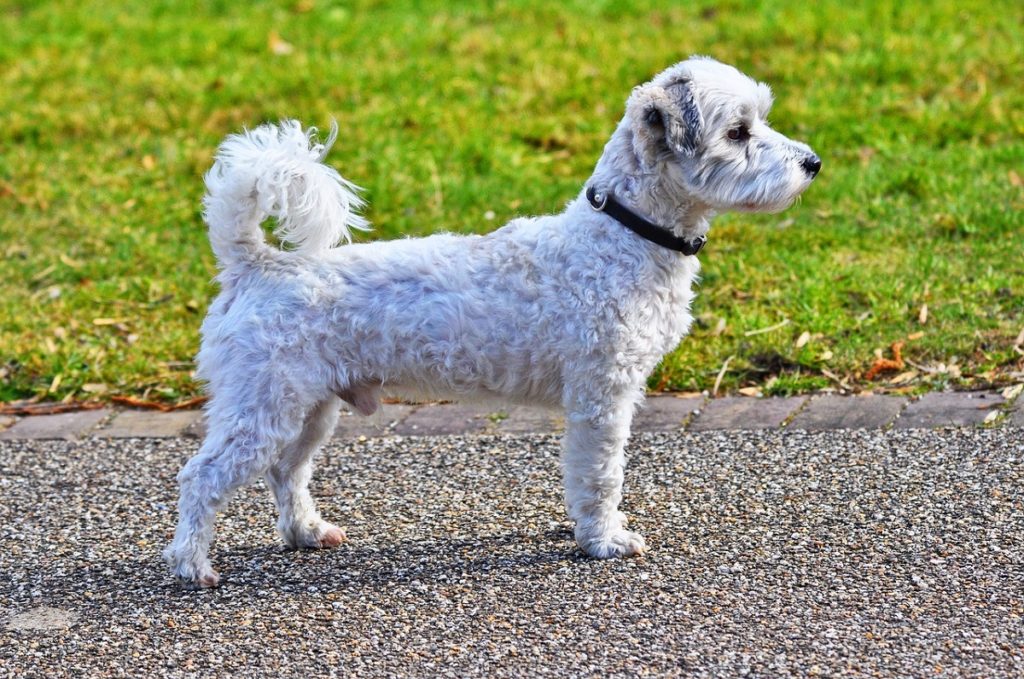Our furry, four-legged canine friends have two extra limbs that are prone to stress, strain, and injury. While us humans only have two legs to carry us around all day and bear the brunt of our weight, dogs have four legs. Dogs are also (in most cases) very active creatures, with loads of curiosity and a desire to investigate pretty much everything. A dog sprained leg can easily happen just from everyday activities or accidents.
Strength is needed to carry their weight around all day, flexibility is needed so that they can jump and chase and, in some cases, climb. Dogs also love to wrestle with their humans and other dogs, run figure eights around the yard, play tug-of-war, and a myriad of other activities. Some dogs love to swim and some dogs are used as work dogs or hunting dogs. All of these activities mean there is significant demands placed upon a dog’s legs and body in general, which means there is also a significant risk for injury and damage.
If you know anything about a dog’s anatomy, you know that most of their day is really spend walking around on their toes. A dog’s knees are often bent, and their ankles are raised. Talk about stress! Could you imagine walking around on your tippy-toes all day? Yet, that’s the way dogs are built and designed. Despite their design, this position is hard on a dog’s joints and muscles, and it’s very easy for them to strain or sprain something, from their shoulders to their toes.
A sprain is considered a soft-tissue injury. Usually, the damage is to the ligaments, the structures that help connect and hold your dog’s bones together and keeps things stable. A dog can sprain just about any joint, although your dog’s ankles, elbows, and knees are the most vulnerable. Note that there is a difference between a dog spraining their leg and a dog straining their leg. Though the symptoms are often the same, the injuries are not. Minor fractures and bone degeneration can also mirror the symptoms of a sprained leg, but the treatments will not be the same.
Difference Between a Sprained or Strained Leg in Dogs
When a dog strains their leg, this is usually the result of a hyper-extension of their muscles. A strain involves the tendons in your dog’s leg, which is the tissue that links your muscles and bones together. Dogs that are very active are more prone to strains, especially in areas like their thighs or their hips.
When a dog sprains their leg, however, this is different. A sprain injures your dog’s ligaments and can cause damage to the joints. A dog can sprain their leg whether they are highly active or largely sedentary. All they have to do is step wrong and they can sprain their leg. Dogs most often will sprain the wrist and knee areas. One of the most painful and serious types of sprains in a dog is a sprain of the CCL. The CCL is the cranial cruciate ligament that connects the knee bones together. When this ligament rips or tears, it can cause excruciating pain for your dog.
Types of Sprains in Dogs
A sprained leg is the most common source of pain for a dog. Dogs will often sprain their elbow or wrist joints, as well as knees. Sometimes a dog might sprain their hip or shoulder, although it’s not as common. Your dog can sprain pretty much anything if there is a ligament located there, including their back, their neck, their jaw, and even their tail. Sprains in your dog’s jaw can hinder your dog’s ability to chew, while sprains of their neck and back can cause intense pain and angst. In most cases though, dogs will sprain their leg.
What Causes a Dog to Sprain Their Leg?
Dogs can sprain their leg all kinds of ways. A sprain usually occurs when a dog’s joint is moved sharply in a direction it’s not meant to move. This causes the ligaments to stretch in an unnatural way and even tear. A sprained leg could be due to major trauma or injury, such as getting hit by a car. Dogs can also sprain their legs fighting with other dogs, wrestling with their humans, or just playing, jumping, and being their typically active selves.
Some dogs have even sprained their leg merely by stepping into a hole or jumping off the couch. Spraining their leg is not hard to do, especially if you’ve got just the right amount of pressure that hits your dog’s ligament at just the right angle. Other things like your dog’s environment can also be a factor. If your dog is exposed to conditions where it is slippery or muddy, he can equality move or twist in a way that causes him to sprain his leg.
Symptoms of a Sprained Leg in Dogs
 A dog can experience a variety of different symptoms related to a sprained leg. Some of those symptoms may be mild, almost unnoticeable. In other cases, the symptoms could be extremely distressing, depending on how bad the sprain is. Unfortunately, sprain symptoms can mimic the symptoms of other problems, such as hairline fractures, strains of the muscles and tendons, bone degeneration, and even canine bone cancer. It’s important to see your vet so that they can make sure you’re really dealing with a sprained leg and not something else like a broken bone in dogs or even a type of cancer. Signs your dog may have potentially sprained his leg includes:
A dog can experience a variety of different symptoms related to a sprained leg. Some of those symptoms may be mild, almost unnoticeable. In other cases, the symptoms could be extremely distressing, depending on how bad the sprain is. Unfortunately, sprain symptoms can mimic the symptoms of other problems, such as hairline fractures, strains of the muscles and tendons, bone degeneration, and even canine bone cancer. It’s important to see your vet so that they can make sure you’re really dealing with a sprained leg and not something else like a broken bone in dogs or even a type of cancer. Signs your dog may have potentially sprained his leg includes:
- Mild to excruciating pain
- Swelling of the paws or joints
- Limping or lameness
- Joints that look red and inflamed
- Compulsive licking of the pained area
- Appetite loss
- Decreased interest in playing or normal activities
- Unexpected and unwarranted aggression
If you suspect your dog has sprained his leg, you should seek treatment from your vet as soon as possible. Even if your dog doesn’t seem as though he is in major distress, delaying treatment could cause more significant damage or injury. It’s always better to err on the side of caution than risk causing your dog further pain.
Diagnosing and Treating a Leg Sprain in Dogs
Again, even if your dog’s sprain appears to be mild, with little to no real symptoms, you shouldn’t skip a trip to your vet. Especially if your dog’s symptoms continue beyond 48 hours. Your vet will be able to thoroughly examine your dog, using manual palpations of your dog’s bones and joints to check for warmth, swelling, pain, and whether or not anything feels out of place. They will evaluate how well your dog is moving and walking, and how well they perform other activities, like sitting or lying down.
Your vet may also order X-rays or other imaging tests to get a clearer picture of what might be going on. X-rays can help your vet rule out other health issues, such as broken bones, hairline fractures, or bone degeneration related to aging and canine arthritis. For assessing tissue damage, your vet may want an ultrasound or MRI done.
A vet may give your dog’s sprain a grade of 1,2, or 3. This grade assesses how well your dog’s joint is moving in comparison to your dog’s other legs. If your dog only has a grade 1 sprained leg, it means the joint is moving pretty normally, and your dog most likely will still be walking, despite some possible swelling or pain.
If your dog receives a grade 2 for the sprained leg, it means your vet can feel some looseness. There will most likely be quite a bit of swelling, and your dog might walk but appear to be limping and in pain. With a grade 2 sprain, the joint isn’t functioning completely.
If your vet assesses your dog with a grade 3 sprained leg, this means that the joint is totally flexible, with no support at all from the ligaments. With this type of sprain, your dog will be in severe pain with major damage, and your dog will not be able to walk or put any weight on the injured leg.
Depending on the grade your vet gives your dog’s sprain, your dog may only need minimal care. If your dog is diagnosed with a grade 1 sprain, that might mean splinting the leg to help keep the joint stabilized and giving your dog a regular anti-inflammatory medication to help with pain and swelling. This type of sprain can still take some time to heal, up to several weeks. More severe sprains will take even longer.
If your dog has a grade 2 leg sprain, surgery may be necessary to fully stabilize the joint, along with splinting the injury and giving your dog meds for canine inflammation. Though this sprain is more serious, with proper care there is no reason your dog can’t fully recover and be back to normal once the sprain is completely healed. It will take a little longer, but at least your dog will still have full range of motion.
If your dog is diagnosed with a grade 3 sprain, he will definitely require corrective surgery to repair the damage. Your dog may or may not be able to recover completely from an injury like this. If he does, it will take a significant amount of time. In some cases, your dog might not recover his full range of motion. It’s vital to keep your dog confined as much as possible so that the joint can rest and heal. Too much activity and movement will only slow down the process. Your dog could also run the risk of re-injuring the joint, causing further damage.
Helping Your Dog Recover from a Leg Sprain
It’s important that you follow your vets’ instructions completely when helping your dog recover from a sprained leg. They have to receive all the medications prescribed as your vet has directed or you will run the risk of infection. Plus, pain medications work best when they are given on a schedule. You may have to crate or kennel your dog for a while and only allow him out for brief walks on a short leash. Absolutely no running, jumping, or playing. The more active your dog is, the more risk he runs of hurting himself a second time.
 While your dog is wearing a splint or brace, make sure you keep it clean and dry and remember that because your dog is going to be much less active for his foreseeable future, so you may want to feed him a reduced calorie diet to prevent any canine weight gain. Excess weight will only add to the stress on your dog’s bones and joints, which will delay the entire healing process.
While your dog is wearing a splint or brace, make sure you keep it clean and dry and remember that because your dog is going to be much less active for his foreseeable future, so you may want to feed him a reduced calorie diet to prevent any canine weight gain. Excess weight will only add to the stress on your dog’s bones and joints, which will delay the entire healing process.
Your vet may advise you to apply heat or ice to your dog’s injury or alternate between the two. Sometimes light massage may be recommended, and in certain cases, your dog may need physical therapy once their splint is off. There are different options available, but water therapy is a good, low-impact option if it’s available to you.
Once your dog is healed and given the okay to resume regular activities, you may want to continue keeping him on a reduced-calorie diet and make sure he gets regular exercise and activity to help keep his muscles and joints flexible and strong. Dogs that are obese and largely sedentary are much more vulnerable to sprain injuries.
Remember that prevention is always the best medicine, so take care that your dog stays fit and healthy. Just like with people, a good diet, regular exercise, and a little common sense go a long way in helping your dog avoid future sprains and lasting damage.
Citations:
“Sprains and Strains in Dogs: What They Look Like, How to Treat Them.” WebMD, Accessed 10 Dec 2018. www.pets.webmd.com/dogs/dog-sprains-strains#1.
“Sprains in Dogs – Symptoms, Causes, Diagnosis, Treatment, Recovery, Management, Cost.” Wag!, 6 Dec. 2016, Accessed 10 Dec 2018. www.wagwalking.com/condition/sprains.
“Dog Limping – How to Get Your Dog Back on His Feet.” Vetstreet, Accessed 10 Dec 2018. www.vetstreet.com/care/dog-limping-how-to-get-your-dog-back-on-his-feet.
Montoya, David. “Dog Sprain Symptoms .” Cuteness, 9 Feb. 2017, Accessed 10 Dec 2018. www.cuteness.com/article/dog-sprain-symptoms.




